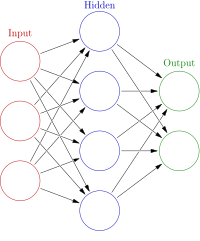
Photo from wikipedia
This paper presents an original approach to the processing and classification of visual evoked potentials signals (SSVEP). It introduces an ensemble learning model that combines canonical correlation analysis with methods… Click to show full abstract
This paper presents an original approach to the processing and classification of visual evoked potentials signals (SSVEP). It introduces an ensemble learning model that combines canonical correlation analysis with methods based on power spectral density. The stimuli used was built using LEDs and ranged from 7.04 Hz up to 38.46 Hz. The data was collect using ADS1299 and three dry electrodes. The tests were performed for different light intensities and different distances between the LEDs. In total, 22 participants were recruited and the mean accuracy was 99.1 ± 2.27 % with a decision time of 1 second. To the best of our knowledge, these results surpass what was previously published in others works that used high frequency stimuli in SSVEP-BCI, i.e., a mean accuracy of approximately 90%, with decision time of 5 seconds.
Journal Title: IEEE Latin America Transactions
Year Published: 2020
Link to full text (if available)
Share on Social Media: Sign Up to like & get
recommendations!